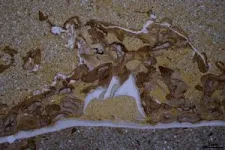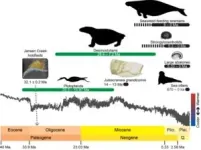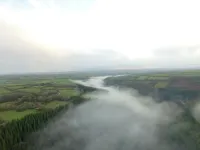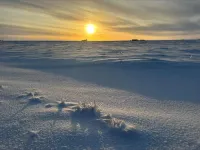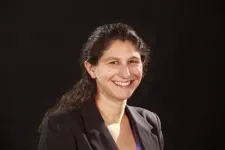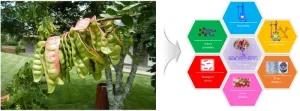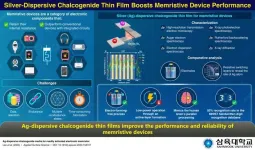(Press-News.org) The unique underwater kelp forests that line the Pacific Coast support a varied ecosystem that was thought to have evolved along with the kelp over the past 14 million years.
But a new study shows that kelp flourished off the Northwest Coast more than 32 million years ago, long before the appearance of modern groups of marine mammals, sea urchins, birds and bivalves that today call the forests home.
The much greater age of these coastal kelp forests, which today are a rich ecosystem supporting otters, sea lions, seals, and many birds, fish and crustaceans, means that they likely were a main source of food for an ancient, now-extinct mammal called a desmostylian. The hippopotamus-sized grazer is thought to be related to today's sea cows, manatees and their terrestrial relatives, the elephants.
"People initially said, “We don't think the kelps were there before 14 million years ago because the organisms associated with the modern kelp forest were not there yet,’" said paleobotanist Cindy Looy, professor of integrative biology at the University of California, Berkeley. "Now, we show the kelps were there, it's just that all the organisms that you expect to be associated with them were not. Which is not that strange, because you first need the foundation for the whole system before everything else can show up."
Evidence for the greater antiquity of kelp forests, reported this week in the journal Proceedings of the National Academy of Sciences, comes from newly discovered fossils of the kelp’s holdfast — the root-like part of the kelp that anchors it to rocks or rock-bound organisms on the seafloor. The stipe, or stem, attaches to the holdfast and supports the blades, which typically float in the water, thanks to air bladders.
Looy's colleague, Steffen Kiel, dated these fossilized holdfasts, which still grasp clams and envelop barnacles and snails, to 32.1 million years ago, in the middle of the Cenozoic Era, which stretches from 66 million years ago to the present. The oldest previously known kelp fossil, consisting of one air bladder and a blade similar to that of today's bull kelp, dates from 14 million years ago and is in the collection of the University of California Museum of Paleontology (UCMP).
"Our holdfasts provide good evidence for kelp being the food source for an enigmatic group of marine mammals, the desmostylia," said Kiel, lead author of the paper and a senior curator at the Swedish Museum of Natural History in Stockholm. "This is the only order of Cenozoic mammals that actually went extinct during the Cenozoic. Kelp had long been suggested as a food source for these hippo-sized marine mammals, but actual evidence was lacking. Our holdfasts indicate that kelp is a likely candidate."
According to Kiel and Looy, who is the senior author of the paper and UCMP curator of paleobotany, these early kelp forests were likely not as complex as the forests that evolved by about 14 million years ago. Fossils from the late Cenozoic along the Pacific Coast indicate an abundance of bivalves — clams, oysters and mussels — birds and sea mammals, including sirenians related to manatees and extinct, bear-like predecessors of the sea otter, called Kolponomos. Such diversity is not found in the fossil record from 32 million years ago.
"Another implication is that the fossil record has, once again, shown that the evolution of life — in this case, of kelp forests — was more complex than estimated from biological data alone," Kiel said. "The fossil record shows that numerous animals appeared in, and disappeared from, kelp forests during the past 32 million years, and that the kelp forest ecosystems that we know today have only evolved during the past few million years."
The value of fossil hunting amateurs
The fossils were discovered by James Goedert, an amateur fossil collector who has worked with Kiel in the past. When Goedert broke open four stone nodules he found along the beach near Jansen Creek on the Olympic Peninsula in Washington, he saw what looked like the holdfasts of kelp and other macroalgae common along the coast today.
Kiel, who specializes in invertebrate evolution, agreed and subsequently dated the rocks based on the ratio of strontium isotopes. He also analyzed oxygen isotope levels in the bivalve shells to determine that the holdfasts lived in slightly warmer water than today, at the upper range of temperatures found in modern kelp forests.
Looy reached out to co-author Dula Parkinson, a staff scientist with the Advanced Light Source at Lawrence Berkeley National Laboratory, for help obtaining a 3D X-ray scan of one of the holdfast fossils using Synchrotron Radiation X-ray Tomographic Microscopy (SRXTM). When she reviewed the detailed X-ray slices through the fossil, she was amazed to see a barnacle, a snail, a mussel and tiny, single-celled foraminifera hidden within the holdfast, in addition to the bivalve on which it sat.
Looy noted, however, that the diversity of invertebrates found within the 32-million-year-old fossilized holdfast was not as high as would be found inside a kelp holdfast today.
"The holdfasts are definitely not as rich as they would be if you would go to a kelp ecosystem right now," Looy said. "The diversifying of organisms living in these ecosystems hadn't started yet."
Kiel and Looy plan further studies of the fossils to see what they reveal about the evolution of the kelp ecosystem in the North Pacific and how that relates to changes in the ocean-climate system.
Other co-authors of the paper are Rosemary Romero, a specialist in algae who obtained her Ph.D. from UC Berkeley in 2018 and is now an environmental scientist with the California Department of Fish and Wildlife; paleobotanist Michael Krings at Ludwig-Maximilians-Universität in Munich, Germany; and former UC Berkeley undergraduate Tony Huynh. Goedert is a research associate at the Burke Museum of Natural History and Culture at the University of Washington, Seattle.
END
Pacific kelp forests are far older that we thought
32-million-year-old fossil holdfasts show kelp far predate animals we see in kelp forests today
2024-01-15
ELSE PRESS RELEASES FROM THIS DATE:
Erectile dysfunction medications may increase risk of death when combined with common chest pain medication
2024-01-15
Phosphodiesterase type 5 inhibitors (PDE5i)—an erectile dysfunction drug sold under the names Viagra, Levitra, Cialis, and others—are a common medical treatment for erectile dysfunction (ED) in men with cardiovascular disease (CVD). However, a new Swedish study published today in the Journal of the American College of Cardiology suggests that patients are at higher risk for morbidity and mortality over time when PDE5is and nitrate medication are both prescribed.
Erectile dysfunction is a common condition in middle-aged and older men and is a strong predictor of coronary ...
Key moment in the evolution of life on Earth captured in fossils
2024-01-15
Curtin-led research has for the first time precisely dated some of the oldest fossils of complex multicellular life in the world, helping to track a pivotal moment in the history of Earth when the seas began teeming with new lifeforms - after four billion years of containing only single-celled microbes.
Lead author PhD student Anthony Clarke, from the Timescales of Mineral Systems Group within Curtin’s School of Earth and Planetary Sciences, said to determine the age of the fossils, researchers used volcanic ash layers like bookmarks in the geological sequence.
“Located ...
Chasing the light: Sandia study finds new clues about warming in the Arctic
2024-01-15
ALBUQUERQUE, N.M. — The Arctic, Earth’s icy crown, is experiencing a climate crisis like no other. It’s heating up at a furious pace — four times faster than the rest of our planet. Researchers at Sandia National Laboratories are pulling back the curtain on the reduction of sunlight reflectivity, or albedo, which is supercharging the Arctic’s warming.
The scientists are not armed with parkas and shovels. Instead, they have tapped into data from GPS satellite radiometers, capturing the sunlight bouncing off the Arctic. This ...
Physicists identify overlooked uncertainty in real-world experiments
2024-01-15
The equations that describe physical systems often assume that measurable features of the system — temperature or chemical potential, for example — can be known exactly. But the real world is messier than that, and uncertainty is unavoidable. Temperatures fluctuate, instruments malfunction, the environment interferes, and systems evolve over time.
The rules of statistical physics address the uncertainty about the state of a system that arises when that system interacts with its environment. But they’ve ...
Kessler Foundation receives grant to investigate impact of combining aerobic exercise and virtual reality for individuals with multiple sclerosis
2024-01-15
East Hanover, NJ – January 15, 2024 – Kessler Foundation received a $39,994 grant from the Consortium of Multiple Sclerosis Centers to investigate the impact of a unique combination of a single bout of aerobic cycling and virtual reality (VR) on processing speed in persons with multiple sclerosis (MS) and mobility disability.
Processing speed is the most common cognitive problem in persons with MS and may actually contribute to broader cognitive difficulties, according to the grant recipient, Carly Wender, PhD, research scientist in the Center for Neuropsychology ...
The power of pause: Controlled deposition for effective and long-lasting organic devices
2024-01-15
Organic optoelectronic devices, such as organic light-emitting diodes (OLEDs), use molecules with specific structures arranged on thin films. Additionally, the arrangement of these molecules on any surface is crucial for various processes that occur within these devices. This arrangement is guided by two primary factors: the deposition rate (how fast the molecules are placed) and the surface temperature. Slower deposition rates and higher temperatures facilitate the proper arrangement, resulting in more stable structures. Finding the right time scale for this process is also critical, and ...
Going beyond plastic: Chung-Ang University team explores tara gum as a green polymer
2024-01-15
Synthetic, non-biodegradable plastics are major sources of environmental pollution and have prompted a rising interest in sustainable, biodegradable alternatives derived from natural polymers. “Tara gum,” derived from the seeds of the tara tree (Caesalpinia spinosa), stands out as a promising solution. This natural, water-soluble substance contains polysaccharides (complex carbohydrates), including the widely used “galactomannan,” which is employed in coatings, edible films, and as a stabilizer and thickener. The biocompatibility, biodegradability, and safety of tara gum also make it valuable in industries like food and drug delivery. ...
Sahmyook University researchers open doors to next-generation memristive devices
2024-01-15
Memristive devices constitute a category of devices capable of retaining their internal resistance, thus offering superior performance compared to conventional devices that use integrated circuits. Several materials have been explored to manufacture these devices. In recent years, transition metal oxides have gradually become widely popular for this purpose.
Due to their increasing application in diverse domains like artificial intelligence systems, memristive devices must now overcome several issues related to data retention, endurance, and a large number of conductance states. Moreover, the individual fabrication ...
Study quantifies how aquifer depletion threatens crop yields
2024-01-15
Three decades of data have informed a new Nebraska-led study that shows how the depletion of groundwater — the same that many farmers rely on for irrigation — can threaten food production amid drought and drier climes.
The study found that, due in part to the challenges of extracting groundwater, an aquifer’s depletion can curb crop yields even when it appears saturated enough to continue meeting the demands of irrigation. Those agricultural losses escalate as an aquifer dwindles, the researchers reported, so that its ...
When bees nourish their microbiota
2024-01-15
Two teams from UNIL and EPFL have succeeded in demonstrating that the insect synthesizes nutrients for native gut microbes. A study published in « Nature Microbiology ».
Bacteria have adapted to all terrestrial environments. Some have evolved to survive in the gut of animals, where they play an important role for their host; they provide energy by degrading indigestible food, they train and regulate the immune system, they protect against invasion by pathogenic bacteria, and they synthesize neuroactive molecules that regulate the behavior and cognition of their host.
These are great ...
LAST 30 PRESS RELEASES:
Tracing the quick synthesis of an industrially important catalyst
New software sheds light on cancer’s hidden genetic networks
UT Health San Antonio awarded $3 million in CPRIT grants to bolster cancer research and prevention efforts in South Texas
Third symposium spotlights global challenge of new contaminants in China’s fight against pollution
From straw to soil harmony: International team reveals how biochar supercharges carbon-smart farming
Myeloma: How AI is redrawing the map of cancer care
Manhattan E. Charurat, Ph.D., MHS invested as the Homer and Martha Gudelsky Distinguished Professor in Medicine at the University of Maryland School of Medicine
Insilico Medicine’s Pharma.AI Q4 Winter Launch Recap: Revolutionizing drug discovery with cutting-edge AI innovations, accelerating the path to pharmaceutical superintelligence
Nanoplastics have diet-dependent impacts on digestive system health
Brain neuron death occurs throughout life and increases with age, a natural human protein drug may halt neuron death in Alzheimer’s disease
SPIE and CLP announce the recipients of the 2025 Advanced Photonics Young Innovator Award
Lessons from the Caldor Fire’s Christmas Valley ‘Miracle’
Ant societies rose by trading individual protection for collective power
Research reveals how ancient viral DNA shapes early embryonic development
A molecular gatekeeper that controls protein synthesis
New ‘cloaking device’ concept to shield sensitive tech from magnetic fields
Researchers show impact of mountain building and climate change on alpine biodiversity
Study models the transition from Neanderthals to modern humans in Europe
University of Phoenix College of Doctoral Studies releases white paper on AI-driven skilling to reduce burnout and restore worker autonomy
AIs fail at the game of visual “telephone”
The levers for a sustainable food system
Potential changes in US homelessness by ending federal support for housing first programs
Vulnerability of large language models to prompt injection when providing medical advice
Researchers develop new system for high-energy-density, long-life, multi-electron transfer bromine-based flow batteries
Ending federal support for housing first programs could increase U.S. homelessness by 5% in one year, new JAMA study finds
New research uncovers molecular ‘safety switch’ shielding cancers from immune attack
Bacteria resisting viral infection can still sink carbon to ocean floor
Younger biological age may increase depression risk in older women during COVID-19
Bharat Innovates 2026 National Basecamp Showcases India’s Most Promising Deep-Tech Ventures
Here’s what determines whether your income level rises or falls
[Press-News.org] Pacific kelp forests are far older that we thought32-million-year-old fossil holdfasts show kelp far predate animals we see in kelp forests today

